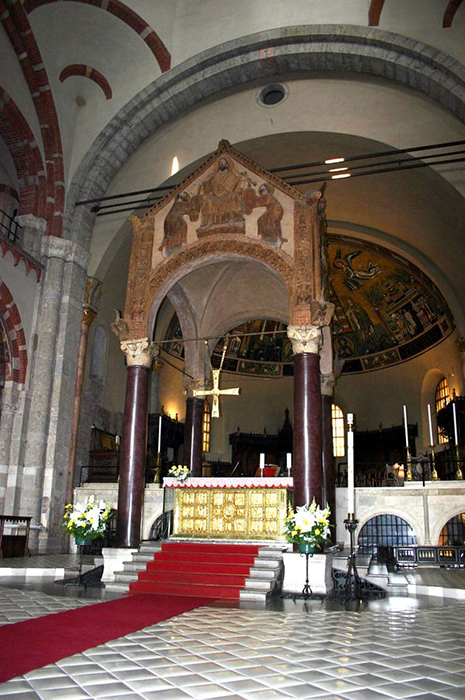
This article is dedicated to ciborium, a distinct architectural object in a Christian temple. In modern churches, this construction is rare, but if you visit ancient churches, you will notice a particular canopy covering the holy altar. What is the meaning of ciborium and what is its history and origin?
The Origin
The history of the ciborium (Greek Κιβώριον, lat. Ciborium) goes back centuries. It is believed that the word “ciborium” derives from the Egyptian name for lotus fruit (another version suggests bean shell), which was used as a drinking vessel. Later, the Greeks began using the name for a metal vessel of a similar shape. In terms of its architectural purpose, the ciborium is very close to baldaquin, a canopy made of expensive fabrics, used to protect rulers from heat and rain. Many known archaeological artefacts show images of various gods and rulers under a characteristic shade, symbolizing heavenly protection. For the first time, such canopies were used in Ancient Egypt, as well as the ancient eastern states of Assyria, Babylon and Persia. From these countries, the canopy migrated into the Greco-Roman culture, where it was also used both for practical purposes and in the cult of emperors. Baldaquins began to be associated with wealth and honor, and consequently with power, both secular and spiritual. The desire of the ancient man to somehow highlight, protect, or give weight to any object, often sacred, was expressed in the arrangement of the baldaquin. With the advent of Christianity, the church adopted this architectural solution with ease and widely used it in architecture and worship.

Ciborium in Christian Churches
Perhaps the first prototype of the ciborium was a recognizable canopy erected over the Holy Sepulcher by Emperor Constantine. Imitating Jerusalem, Christians began to erect ciboria over church altars, thereby emphasizing their preeminent sacredness and key importance, as places for celebrating the Eucharist, hence the special presence of God in the temple. A ciborium could be placed not only above the altar, but also above other important centers of worship. For example, it could be built over a baptismal font or holy springs to emphasize the uniqueness of the Sacrament of Baptism. The ciborium often overshadowed the ambo (Syrian tradition) as a sacramental place for the proclamation of the Word of God. As veneration of saints became more and more common, particular canopies were created over the martyrs’ tombs and their relics, atop which, according to the Christian tradition, altars were also erected. Ciboria were also built over cathedras of holy hierarchs, emphasizing the importance of their episcopal ministry, without which the church cannot exist.

Ciborium over the Altar
Perhaps most ancient surviving altar ciboria are located in the Milan Basilica of St Ambrose and at the Basilica of Sant’Apollinare in Classe in Ravenna. Unfortunately, the richly decorated ciborium with gold and precious stones, donated by the Emperor Justinian to the Church of St Sophia and described by the Greek poet Paulus Silentiarius, has not survived. Besides protecting the altar table from dust, the ciborium also served to attract the worshippers’ glances to the spiritual center of the temple. There is evidence (Encyclopaedia of Christianity, Rome, 1978) that the word “ciborium” was also used for a separate tabernacle for the Holy Gifts, often made in the form of a dove. It was called “περιστερεων” (Greek dovecote) in Greek tradition and was hung on chains from the altar hallway and, in case of need, was lowered to the altar table.

According to ancient chronicles, ciboria were draped on all sides with catapetasms, which were rolled up at certain points of service. In that way, the veil hid from the faithful not the entire altar, but only the altar table space under the ciborium. The modern church curtain, separating the altar from the naos, together with the iconostasis, appeared not earlier than the 11th century. In Russia, ciboria were erected only in large cathedrals. Notably their construction was considered so important that it was included in the annals (Dobronravov, 1912). This can be explained by the belief existing since the time of St Simeon of Thessalonica, that the consecration of the temple and its entire structure was considered completed only after the ciborium was established over its altar. Such an importance of the ciborium can be explained by the symbolic meaning that it had in the eyes of Christians. St Herman of Constantinople asserted that “The ciborium represents here the place where Christ was crucified; for the place where He was buried was nearby and raised on a base. It is placed in the church in order to represent concisely the crucifixion, burial, and resurrection of Christ. It similarly corresponds to the ark of the covenant of the Lord in which, it is written, is His Holy of Holies and His holy place “(On the Divine Liturgy, 5).

Recently, more and more new Orthodox churches are being designed with a ciborium in the altar, usually combined with a low iconostasis. Such projects successfully fulfill a double task. On the one hand, low iconostases do not create a certain unjoint between the clergy and the faithful, allowing the “royal priesthood” of the laity to participate more fully in the Liturgy, with the altar as its focus point. On the other hand, the presence of a ciborium overshadowing the Lord’s Table testifies to the fact that one should gaze with fear and trembling at the Sacrament of the Altar. This is how the church teaches her children piety, using various temple constructions where the truth of the Gospel is engraved in stone, marble and wood.




